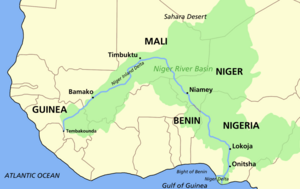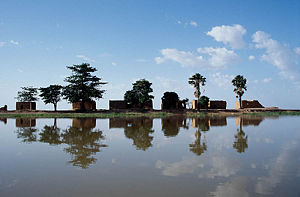Niger River
The Niger River is the principal river of western Africa, extending over 2,500 miles (about 4,180 km). It runs in a crescent through Guinea, Mali, Niger, on the border with Benin and then through Nigeria, discharging through a massive delta, known as the Oil Rivers, into the Gulf of Guinea. The Niger is the third longest river in Africa, exceeded only by the Nile and the Congo River (also known as the Zaïre River). Its main tributary is the Benue River.
During the years when the slave trade flourished, nearly half the total number of slaves exported from Africa came from the Niger delta.
About a thousand years ago, in the prime years of the Mali empire, traders brought gold by pirogue down the Niger from Ghana to Timbuktu, whence it was carried by camel to Tripoli and Alexandria.
Etymology
The origin of the name Niger is unknown. It is often assumed that it derives from the Latin word for "black", Niger, but there is no evidence for this, and it would have been more likely for Portuguese explorers to have used their own word, negro, or preto as they did elsewhere in the world. In any case the Niger is not a blackwater river.
The name is thus thought to be indigenous, but no convincing origin has been found among the thirty languages of the Niger delta and lower reaches of the river. One hypothesis is that it comes from the Tuareg phrase gher n gheren "river of rivers" (shortened to ngher), originating in the middle reaches of the river around Timbuktu.
The nations of Nigeria and Niger are named after the river. The people who live along it have a variety of names for it, notably Jeliba in Manding, Isa Ber ("big river" in Songhay), Joliba (a Mandigo word meaning Great River), and Kworra or Quorra. By the last name the Niger was known in its lower reaches before its identity with the upper river was established. The Romans had heard of the Niger and called it Dasibari.
Geography
The Niger River is a relatively "clear" river, carrying only a tenth as much sediment as the Nile because the Niger's headlands are located in ancient rocks that provide little silt.[1] Like the Nile, the Niger floods yearly; this begins in September, peaks in November, and finishes by May.[2]
An unusual feature of the river is the Niger Inland Delta, which forms where its gradient suddenly decreases.[3] The result is a region of braided streams, marshes, and lakes the size of Belgium; the seasonal floods make the Delta extremely productive for both fishing and agriculture.[4]
The Niger takes one of the most unusual routes of any major river, a boomerang shape that baffled European geographers for two millennia. Its source is just 150 miles (240 km) inland from the Atlantic Ocean, but the river runs away from the sea into the Sahara Desert, then takes a sharp right turn and heads southeast to the Gulf of Guinea.
Romans thought that the river near Timbuktu was part of the Nile River (e.g., Pliny, N.H. 5.10), a belief also held by Ibn Battuta, while early seventeenth-century European explorers thought that it flowed west and joined the Senegal River. The true course was probably known to many locals, but Westerners only established it in the late nineteenth century; it was first mentioned in the book Travels in the Interior of Africa by the Scottish explorer Mungo Park, who traveled up it in the 1790s.
This strange geography apparently came about because the Niger River is two ancient rivers joined together. The upper Niger, from the source past the fabled trading city of Timbuktu to the bend in the current river, once emptied into a now-gone lake, while the lower Niger started in hills near that lake and flowed south into the Gulf of Guinea. As the Sahara dried up in 4000-1000 B.C.E., the two rivers altered their courses and hooked up. (This explanation is generally accepted, although some geographers disagree.)
The northern part of the river, known as the "Niger bend," is an important area because it is the closest major river and source of water to the Sahara Desert. This made it the focal point of trade across the western Sahara and the center of the Sahelian kingdoms of Mali and Gao.
Even in 1796, when Mungo Park reached the Niger, he described the city of Segou thus: "{T]he numerous canoes upon the river; the crowded population, and the cultivated state of the surrounding country, formed altogether a prospect of civilisation and magnificence."
Niger River in fiction
- The downstream stretch served as the setting for Clive Cussler's novel Sahara, and the 2005 film Sahara.
- The river serves as the backdrop for much of T. Coraghessan Boyle's novel Water Music.
- The Niger features prominently in Maryse Condé's historical novel of West Africa, Segu.
ReferencesISBN links support NWE through referral fees
- Marq de Villiers and Sheila Hirtle, Into Africa, 1997. Key Porter Books, Toronto, Canada. ISBN 1550138847
External links
- Information and a map of the Niger's watershed
- Map of the Niger River basin at Water Resources eAtlas
- Niger Currents: Exploring life and technology along the Niger River
International law and the River Niger
- Bibliography on Water Resources and International Law See Niger River. Peace Palace Libray
- Fabio Spadi, "The ICJ Judgment in the Benin-Niger Border Dispute: the interplay of titles and ‘effectivités’ under the uti possidetis juris principle", Leiden Journal of International Law(2005) 4, pp. 777-794.
Credits
New World Encyclopedia writers and editors rewrote and completed the Wikipedia article in accordance with New World Encyclopedia standards. This article abides by terms of the Creative Commons CC-by-sa 3.0 License (CC-by-sa), which may be used and disseminated with proper attribution. Credit is due under the terms of this license that can reference both the New World Encyclopedia contributors and the selfless volunteer contributors of the Wikimedia Foundation. To cite this article click here for a list of acceptable citing formats.The history of earlier contributions by wikipedians is accessible to researchers here:
The history of this article since it was imported to New World Encyclopedia:
Note: Some restrictions may apply to use of individual images which are separately licensed.


